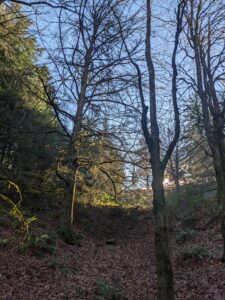February is when it starts to feel like spring in the Arboretum. There is the occasional sunny day and many trees and shrubs are beginning to bud. The blooms, colors, scents, and textures of the Winter Garden are still exquisite and Magnolia Trail feels alive this time of year.
Winter Weather
Winter weather like snow and ice can occur in February at the Arboretum. Plan ahead and check our Recent Updates page for information about Visitor Center and park road closures resulting from unsafe conditions. Otherwise, make sure you dress for the weather before your visit! Wear layers and shoes that can get muddy!
This Month at Hoyt Arboretum


When deciduous trees lose their leaves each year, one of their most identifying characteristics is gone. But all is not lost! Join arborist Casey Clapp, creator and co-host of the tree podcast Completely Arbortrary, in this identification course focused on what the leaves leave behind: the twigs. This course will be an introduction into how to identify trees during the winter time using only their twigs and will feature a quick discussion on what to look for followed by a walk through the Arboretum picking out individual trees and examples.
Pre-registration is required. Learn more and sign up here.
As a thank you for bringing trees & people together, Hoyt Arboretum Friends members get discounts on classes and workshops. Click here to become a member.
For Youth & Families


Mondays & Saturdays 10:00 -11:15 AM
ages 2-5 with an adult
sign up for specific dates here.
Hoyt Arboretum Friends offers a variety of programs and resources to help youth and families engage with trees and nature at Hoyt Arboretum. Explore our guided and self-guided programs here.
Stop by the Visitor Center (10:00 AM-4 PM daily) to pick up a Children’s Adventure Map and a Winter Nature Search.
The Winter Garden


Color, texture, scent, and capital “L”ife to explore in the Winter Garden. Take advantage of the long, sunny weekend to enjoy (it’s still cold- wear layers!).
Stop by the Visitor Center for a map and directions (10am-4pm daily).
For a self guided tour of the plants of the Winter Garden:
1. Visit our Plant Database
2. Click the “Tours” tab from the nav bar
3. Select the “Winter Garden Tour” from the dropdown menu
4. Learn more about the amazing plants in this cheerful sanctuary
PRO TIP: load the tour before you arrive (cell service and wifi can be spotty up here).
Stay Up-To-Date with Hoyt Arboretum!
Subscribe to our email newsletter
AND
